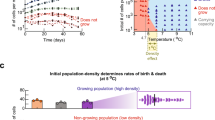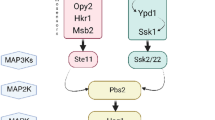Summary
Parameters of thermal death were determined in 10 strains of yeast species whose maximum temperatures for growth (T max) ranged from 22 to 49°C. Arrhenius plots of the specific thermal death rates (k d) formed a positional sequence at the level of the experimental points that corrresponded in all but one case to the sequence of the respective T max values. Extrapolated k d values at higher or lower temperatures no longer formed this sequence.
The correlation of the temperature functions with T max could be characterized in terms of a new activation parameter, for which the name thermal death activation constant is introduced. It has the following form: T.D.A. \(constant = \frac{{\Delta {\rm H} \ne }}{{T_{\max + n} }}\) − ΔS≠ where ΔH≠ and ΔS≠ are respectively the apparent heat and entropy of activation of thermal death and n is the number of degrees above T max (expressed in °K) at which the T.D.A. constant exists.
Seven mesophilic yeasts had a T.D.A. constant between 72 and 79 calxmol-1 degree-1 at n values between 1 and 4°. This suggested that the destructive process that limits k d in these strains is of the same species as one that contributes to the establishment of T max. Two psychrophilic yeasts apparently had a similar T.D.A. constant but at a high n value (about 12.5°C) which suggested that in these strains T max is governed by a destructive process unrelated to the one that underlies thermal death. The strain of the nearly thermophilic Hansenula angusta (T max 49°C) did not fit in either group.
The significance of the T.D.A. constant is discussed and expressions for ΔH≠ and ΔS≠ in terms of bond activation parameters are proposed.
Similar content being viewed by others
References
Biltonen, R.: Reversible conformational isomerization of α-chymotrypsin and various derivatives. Thesis, University of Minnesota, U.S.A. 1965.
Brandts, J. F.: Heat effects on proteins and enzymes. In: Rose, A. H.: Thermobiology, pp. 25–72. London-New York: Academic Press 1967.
Christophersen, J.: Mikroorganismen. In: Precht, H., J. Christophersen u. H. Hensel. Temperature und Leben, S. 178–328. Berlin-Göttingen-Heidelberg: Springer 1955.
Eyring, H.: The activated complex and the absolute rate of chemical reactions. Chem. Rev. 17, 65–77 (1935).
—, and A. E. Stearn: The application of the theory of absolute reaction rates to proteins. Chem. Rev. 24, 253–270 (1939).
Farrell, J., and A. H. Rose: Temperature effects on micro-organisms. In: Rose, A. H.: Thermobiology, pp. 147–218. London-New York: Academic Press 1967a.
——: Temperature effects on microorganisms. Ann. Rev. Microbiol. 21, 101–120 (1967b).
Hinshelwood, C. N.: The chemical kinetics of the bacterial cell. Oxford: Clarendon Press 1946.
Ingraham, J. L.: Temperature relationships. In: Gunsalus, I. C., and R. Y. Stanier: The Bacteria, Vol. IV, pp. 265–298. New York-London: Academic Press 1962.
Johnson, F. H., H. Eyring, and M. J. Polissar: The kinetic basis of molecular biology. New York: John Wiley & Sons, Inc. 1954.
Mirsky, A. E., and L. Pauling: On the structure of native, denatured and coagulated proteins. Proc. nat. Acad. Sci. (Wash.) 22, 439–447 (1936).
Stearn, A. E.: Kinetics of biological reactions with special reference to enzyme processes. Advance Enzymol. 9, 25–74 (1949).
Woese, C.: Thermal inactivation of animal viruses. Ann. N. Y. Acad. Sci. 83, 741–751 (1960).
Wood, T. H.: Lethal effects of high and low temperatures on unicellular organisms. Advance Biol. Med. Phys. 4, 119–165 (1956).
Author information
Authors and Affiliations
Rights and permissions
About this article
Cite this article
van Uden, N., Abranches, P. & Cabeça-Silva, C. Temperature functions of thermal death in yeasts and their relation to the maximum temperature for growth. Archiv. Mikrobiol. 61, 381–393 (1968). https://doi.org/10.1007/BF00409674
Received:
Issue Date:
DOI: https://doi.org/10.1007/BF00409674




